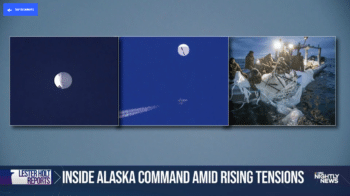The “Chinese Spy Balloon” has been an important story for fueling New Cold War animus against China, but it is based on a dubious premise. While the phrase “Chinese Spy Balloon” has been repeated ad nauseam in the U.S. press (FAIR.org, 2/10/23), no publicly available information exists to support that claim (Caitlin’s Newsletter, 2/14/23). While some officials still claim without proof that “we know for sure it was a spy vehicle,” the level of fearmongering from the press was certainly unwarranted. U.S. intelligence agencies had actually tracked the balloon since its launch at Hainan Island (Washington Post, 2/14/23), and after intercepting the balloon with fighter jets, according to the head of NORAD, they quickly “determined it wasn’t a hostile threat” (NBC News, 7/20/23).

NBC News (7/24/23): Three views of the Chinese balloon.
Even if the balloon was spying, the Pentagon quickly asserted that there would not be “significant value added over and above what the PRC is likely able to collect through things like satellites in Low Earth Orbit.” Or as the Pentagon spokesperson put it: “Does it pose a significantly enhanced threat on the intelligence side? Our best assessment right now is that it does not.” Another Pentagon official later acknowledged that the balloon “did not collect [intelligence] while it was transiting the United States or flying over the United States.”
Based on weather models, the Washington Post (2/14/23) noted that the most likely cause of the balloon’s unusual course was unexpected wind patterns, raising “the possibility that China didn’t intend to penetrate the American heartland with its airborne surveillance device.”
Despite the lack of any clear threat, the Biden administration blew it out of the sky, along with several other balloons. According to Biden himself (2/16/23), these latter balloons were all “most likely balloons tied to private companies, recreation or research institutions studying weather or conducting other scientific research.” This was almost certainly true in at least one case (Guardian, 2/17/23).
This hysterical reaction by the U.S. not only had consequences on the global stage, but also had the effect of riling up the U.S. public in anti-China fury. As a complement to that, it was also used to fuel concern about our ostensibly inferior military systems, giving advocates an opportunity to demand more resources for the war machine. NBC’s recent segment, “Inside NORAD’s Mission to Defend U.S. Airspace” (7/24/23), is a prime example about how to leverage balloon hysteria into boosting the military/industrial complex.
‘Infamous Chinese balloon’

NBC (7/24/23) illustrates the “strategic importance” of Alaska’s NORAD base.
The factual content of the segment, presented by NBC fixture Lester Holt, is as follows: NBC recounted the Chinese balloon episode, and toured an Alaskan NORAD base. Base personnel’s routine missions include flying air tankers to refuel F22s, so they can intercept other harmless balloons. The technology they have is more than capable of tracking balloons, but NORAD is seeking new technology anyway.
As plain facts, the story hardly comes across as a “story.” However, the stage-managed presentation served a dramatically different purpose. NBC’ s framing is structured so that the new technology NORAD is seeking is portrayed as an important part of America’s defense.
For the NBC report , the first Chinese balloon wasn’t a non-event blown out of proportion, but something that “shined a light” on the “strategic importance” of Alaskan military bases “as adversaries like Russia and China demonstrate new capabilities.” NBC didn’t bother including the Pentagon’s admissions that the balloon was not an intelligence threat, or the likelihood that it drifted into U.S. airspace by accident. Instead, it allowed the earlier pervasive assumption that the balloon represented some kind of crisis to justify the rest of the coverage.
The entire segment also fails to cite any “new capabilities” demonstrated by Russia or China. In fact, if anything, NBC described an even lower intensity than normal: Holt reported that there have actually been fewer Russian planes getting anywhere near U.S. airspace since the Russo-Ukrainian war started. Despite this, Holt asked F16 instructor pilot Maj. Brent Rist, “Is the threat level increasing?” More remarkably, the pilot responded, “I think the threat level is increasing.” If there are fewer Russian planes, then what would the threat be? Nothing was said to support this or follow up, but the key line was delivered unchallenged.
NBC announced that the routine interceptions of other harmless balloons were “critical” missions, citing another balloon interception “just weeks after that infamous Chinese balloon crossed the U.S.” Here, too, NBC decided not to address the actual threat that this balloon posed, so the audience was left to accept on faith that this and similar missions are in fact “critical.”
At one point, Holt asked a radar operations commander whether or not NORAD’s technology was capable of detecting those kinds of balloons. The answer was a resounding yes; the commander explained that the warning systems were set to alert for objects traveling at higher velocity, but operators have since adjusted their warnings to look for other objects.
The segment immediately cut from there to reporting about how NORAD was looking for new technology that could “see over the horizon.” Instead of questioning why NORAD needed new technology, despite the demonstrated lack of threat and the adequate capability of current systems, NBC used the common neutral news segue “this comes as”—a phrase that implies a relationship without having to explain what exactly it is. That slippery language hid the obvious contradiction between the lack of threat and the desire to increase costs.
Selling shoes, soap or empire

NBC‘s Lester Holt (7/24/23) goes up in a military plane because he can.
NBC’s report went to great lengths to avoid questioning the most expensive institution in the federal government. Instead, the segment was tailor-made to appeal to the common American reverence for the military. Images of men in uniform looking serious, complex machinery whirring away, suited-up pilots and action shots of soaring jets that could have been from Top Gun, and Lester Holt on a military plane, with distorted audio as he addressed the audience through his radio headset. All of this heightened the idea that the military is exciting, thrilling and important. The fact that their “critical” job consists of attacking harmless balloons didn’t get in the way of promoting the militaristic American mythos. The message of NBC’s reporting was clear: Russia and China are coming, and we need a robust military to defend ourselves from these threats. The balloon was just a practice run for more threats from Russia and China. The images on screen did the job of reinforcing this message, despite the fact that there was no logical argument about any danger presented to the audience.
But propaganda isn’t about creating a coherent position, but rather about eliciting an emotional response from the audience. This segment can best be compared to an advertisement: Instead of selling shoes, soap or cars, they’re selling a rapidly expanding budget for the machinery of global empire. Much like the over-reliance on think tanks funded by military contractors (FAIR.org, 6/30/23), this sort of coverage contributes to the overall hawkish character of U.S. corporate media.
All of this relies on the internal assumptions of the New Cold War paradigm, in which the U.S. is facing off against Russia and China in a quest for global dominance. As in the old Cold War, much of the escalation comes from U.S. strategy, but American audiences are kept in the dark about that.

